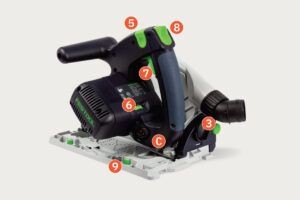A track saw offers a blend of accuracy comparable to a table saw and the convenience of a circular saw, making it a valuable asset for both professional carpenters and passionate DIYers. More budget-friendly than full-sized table saws, these tools excel in various cuts and boast straightforward maintenance. This guide provides a comprehensive overview on How To Use A Track Saw Guide, covering selection, setup, safe operation, and advanced techniques.
Understanding Track Saws and Their Components
A track saw system typically comprises a plunge-cut saw that glides along a guide track. This design enables users to execute precise rip cuts, crosscuts, and bevel cuts. Furthermore, track saws are renowned for producing splinter-free, perfectly straight cuts, rendering them ideal for tasks demanding precision, such as preparing plywood for cabinet construction, trimming doors, and performing plunge cuts for floor repairs. Understanding track saw components is crucial for proper use.
Key Components of a Track Saw System
Track saws consist of two main components: the saw itself and the guide track. Several smaller, yet vital, components contribute to their functionality.
Saw Components
The essential components of the saw include:
- Bevel Adjustment: Allows for angled cuts.
- Blade Guard: Enhances safety by covering the blade.
- Depth Adjustment: Controls the cutting depth.
- Dust Collection Port: Connects to a vacuum system for dust removal.
- Guide Slots: Ensures proper alignment with the track.
- Power Source: Can be corded or cordless, depending on the model.
- Speed Control: Regulates blade speed for different materials.
- Splitter: Prevents the wood from pinching the blade, reducing kickback.
Track Components
The guide track’s components include:
- Clamp Slots: Allow for securing the track to the workpiece.
- Grip Pads: Prevent the track from slipping during use.
- Splinter Guard: Minimizes splintering for clean cuts.
- Varying Lengths: Tracks are available in different lengths to accommodate various project sizes.
Advantages of Using a Track Saw Guide
Track saws offer numerous advantages over traditional cutting methods, including:
- Cost-Effectiveness: More affordable than full-sized table saws.
- Portability: Easy to transport to different job sites.
- Precision: Delivers accurate, splinter-free cuts, enhancing the quality of your work.
- Safety: Enclosed blade design reduces the risk of accidental injury.
- Versatility: Capable of making rip cuts, crosscuts, and bevel cuts with ease.
How to Select the Right Track Saw
Selecting the appropriate track saw hinges on your specific requirements, financial constraints, and the projects you intend to undertake. Consider the Ryobi 18V ONE+ HP Brushless 6 1/2-inch Track Saw as an economical cordless option for DIYers and budget-conscious professionals. Alternatively, the Kreg Adaptive Cutting System Saw and Guide Kit is a good corded option. The DeWalt Corded Track Saw is another excellent choice, known for its compatibility with tracks from other manufacturers.
Step-by-Step Guide: How to Use a Track Saw Guide
Mastering the use of a track saw guide involves careful setup and precise operation. Follow these steps for optimal results:
- Preparation: Position the track on a stable, sacrificial surface, such as rigid foam atop a workbench.
- Alignment: Adjust the saw’s position on the track to ensure smooth, wobble-free movement.
- Initial Cut: Set the blade depth to approximately 1/4 inch.
- Scoring the Splinter Guard: Power on the saw and gently lower the blade into the splinter guard along the track.
- Trimming: Move the saw slowly along the track to trim the splinter guard to the appropriate size. This step ensures the splinter guard aligns perfectly with the cutting line.
For precise cuts, measure and mark your cutting line on the material and align the track’s splinter guard with these marks. Secure the track using its grip pads or clamps. Adjust the saw’s depth and bevel settings as needed. Activate the saw, let it reach full speed, and gently plunge the blade into the material. Smoothly guide the saw along the track to complete the cut.
Advanced Techniques for Mastering Your Track Saw
Once you are familiar with basic cuts, exploring advanced techniques like bevel and plunge cuts can enhance your track saw skills.
Mastering Bevel Cuts
To create accurate bevel cuts, follow these steps:
- Measure: Determine the long point of the desired bevel angle.
- Adjust: Set the saw’s bevel to the appropriate angle.
- Set Depth: Adjust the cutting depth according to the material’s thickness.
- Secure Track: Align and secure the track firmly.
- Cut: Make the cut by pushing the saw smoothly along the track, maintaining consistent pressure and speed.
Executing Plunge Cuts
Plunge cuts are essential for projects such as installing wood flooring or cutting openings in countertops. Here’s how to execute them correctly:
- Adjust Depth Stop: Set the depth stop to the desired cutting depth.
- Align: Position the saw’s plunge mark with your starting point.
- Engage: Activate the anti-kickback lock for added safety.
- Plunge: Start the saw and slowly lower the blade into the material.
- Push Forward: Continue pushing the saw forward to complete the cut along the marked line.
- Finish: Once you reach the end of your marked line, allow the blade to come to a complete stop before raising it out of the material.
Creating Straight Edges on Rough Lumber
Track saws can create straight edges on rough-sawn lumber. Place the board on a stable surface and position the track along the board’s length, ensuring the rough edge is on the waste side. Secure the track to the board, then make your cut. Utilize the straightened edge as a reference for future cuts.
Additional Track Saw Features and Considerations
Exploring additional track saw features can help maximize your tool’s potential.
Optimizing Dust Collection
Many track saws have a dust collection port to help maintain a clean workspace and extend the tool’s lifespan. Connecting the saw to a dust extractor reduces airborne particles and keeps the cutting line free from debris, improving visibility and accuracy.
Understanding Speed Control and Blade Types
Adjusting blade speed according to the material being cut is possible with some track saws’ speed control feature. Different blades are designed for various materials, including wood, metal, and plastic.
Maintenance and Care
To ensure your track saw stays in top condition, follow these maintenance tips:
- Clean: Regularly clean the track and saw housing to remove dust and debris.
- Maintain Blade: Keep the blade clean and sharp for optimal cutting performance.
- Check Fasteners: Regularly inspect and tighten all bolts and screws to ensure the tool operates safely.
Prioritizing Safety Considerations
Always prioritize safety when operating a track saw. Wear appropriate personal protective equipment (PPE), such as eye and ear protection. When cutting smaller pieces, support any overhanging track, and use clamps to secure the track when working with slippery materials. Ensure the riving knife is engaged, except during plunge cuts. Never reach underneath the workpiece while sawing. Disconnect the power or remove the battery when changing blades or accessories. With proper use and adherence to safety guidelines, a track saw can greatly enhance your woodworking capabilities, providing precision and efficiency for a wide range of projects.


